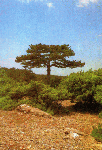

This zone, which is within the adriatic-mediterranean province, encompasses the relatively warmest areas. During at least 50 weeks per year this zone has temperatures above 5 C and during the summer there are long-lasting draughts and heat.
The climazonal forest association Orno-Quercetum illicis is representative for the evergreen vegetation of this zone and within the general Mediterranean order Quercetalia ilicis belongs to the Quercion ilicis alliance. Nonetheless, this association can be found only in the small part of this area in the form of forest because, due to man, it was more or less degraded. Such degradation caused the formation of different very significant permanent vegetative forms in most parts of the area. Those are above all thick and almost impenetrable evergreen shrublands, the so called macchia, which by its floristic structure also belong to the Orno-Quercetum ilicis community. By further degradation macchia became the so called garrigue. This is, short, thinned out heliophyllous thicket which from the phytocoenological point of view belongs to a special endemic alliance Cisto-Ericion (Cisto-Ericetalia order).
 In lower areas with macchia and garrigue as the ground flora grow, especially in southern areas, the most beautiful forests of Pinus halepensis, while some garrigues of the higher areas represent the natural grounds for the development of endemic
forests of Pinus nigra subsp. dalmatica. Due to extreme degradation, all these woodlands and shrublands finally turned into very distinct communities of dry grasslands or, what is even more common to rocky pastures which belong to the illyrian-euromediterranean order
Cymbopogo-Brachypodietalia.
In lower areas with macchia and garrigue as the ground flora grow, especially in southern areas, the most beautiful forests of Pinus halepensis, while some garrigues of the higher areas represent the natural grounds for the development of endemic
forests of Pinus nigra subsp. dalmatica. Due to extreme degradation, all these woodlands and shrublands finally turned into very distinct communities of dry grasslands or, what is even more common to rocky pastures which belong to the illyrian-euromediterranean order
Cymbopogo-Brachypodietalia.
Apart from the above mentioned major vegetation entities various other pioneer and anthropogenous, mostly endemic euro-mediterranean communities which prosper, for instance in fissures, steep limestone rubble, on salty soils in the coastal area, ruderal habitats, in running and stagnant waters etc.